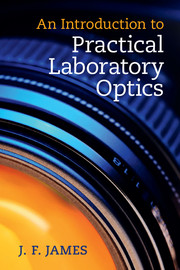Book contents
- Frontmatter
- Contents
- Preface
- 1 Introduction: centred optical systems
- 2 Telescopes and binoculars
- 3 Eyepieces, eyes and colour
- 4 Cameras and camera lenses
- 5 The scientific CCD camera
- 6 Spectrometry
- 7 Interferometers and their uses
- 8 Electro-optical effects and their practical uses
- 9 Microscopes and projectors
- 10 Siderostats and coelostats
- 11 The detection and measurement of radiation
- 12 Practicalities
- Appendix A Gaussian optics
- Appendix B Optical aberrations
- Appendix C A brief introduction to Fourier optics
- Further reading
- Index
- Frontmatter
- Contents
- Preface
- 1 Introduction: centred optical systems
- 2 Telescopes and binoculars
- 3 Eyepieces, eyes and colour
- 4 Cameras and camera lenses
- 5 The scientific CCD camera
- 6 Spectrometry
- 7 Interferometers and their uses
- 8 Electro-optical effects and their practical uses
- 9 Microscopes and projectors
- 10 Siderostats and coelostats
- 11 The detection and measurement of radiation
- 12 Practicalities
- Appendix A Gaussian optics
- Appendix B Optical aberrations
- Appendix C A brief introduction to Fourier optics
- Further reading
- Index
Summary
The most famous and illustrious mis-user of an optical instrument is Sherlock Holmes. There is an iconic figure of him with Inverness cape, deerstalker hat and calabash pipe, peering though a magnifying glass, the latter held at arm's length, to inspect a possible blood stain.
This is the wrong way to use a magnifying glass – which incidentally should always have a plano-convex lens rather than the biconvex lens with which many cheap versions are provided. The glass should be held close to the eye, plane side facing, and the object brought in until it is in clear focus at a comfortable distance for viewing. This gives the clearest image, the widest field and the minimum of optical aberrations. It is the attention to small detail like this which helps ensure success. Watchmakers do it properly, with a loupe, a lens held, like a monocle, in the eye socket.
In experimental science, especially in physics laboratories, it is sometimes found, when beginning a new piece of basic research, that no appropriate apparatus exists and that it is necessary to improvise. The traditional laboratory stand-and-clamp then comes into its own, followed, after some experimentation, by a properly designed system with an optical bench or table with lenses, mirrors and other basic optical elements for measuring and analysing radiation. Skills in the design and assembly of such provisional devices are part of the true experimenter's art.
Information
- Type
- Chapter
- Information
- An Introduction to Practical Laboratory Optics , pp. ix - xPublisher: Cambridge University PressPrint publication year: 2014
